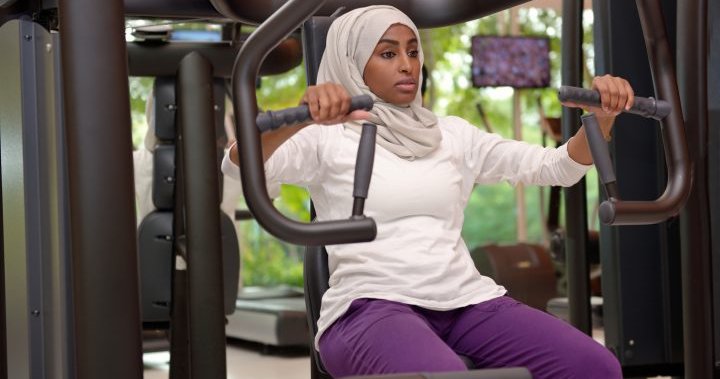Before starting your exercise routine, you must understand your goal and be realistic. Realistically, your goal during this period of Ramadan should be to maintain your current fitness level and lean muscle tissue.
This is not the time for new crazy workout routines.
For those already exercising regularly, you should continue your fitness routine at the lowest intensity and for a shorter duration. This is to prevent muscle loss and weight gain.
You should not train at 100% intensity and stuff yourself with food at night.
How frequently should I work-out every week?
On alternate days or 3 times per week is ideal to maintain lean muscle mass. However, for those who have been exercising very regularly, then you can stick to your 5 to 6 times a week routine.
How long should my workout session be?
At least… 20-45mins per session.
If you want to do more intense workout such as HIIT session, then keep it between 20 to 30mins per session. If it is a light to moderate workout session, you can exercise for up to 45mins.
How intense should my workout be?
Your Ramadan workout should be 30 to 50% less intense than you would normally workout outside Ramadan.
Remember, this is not the time to increase the intensity of your workout or try new crazy exercises.

Stick to your routine
It is helpful to maintain your work-out routine pre-Ramadan. However reduce the weight you lift, number of repetitions, increase rest time, and choose easier options such as regular squats instead of jump squats.
When is the best time to work-out?
It is best to train when you have adequate food and fluids in your body system. Training when fasting can be more harmful than beneficial because training during this period can decrease strength and muscle mass significantly.
Research has shown that muscle dehydration of as little as 3% can cause a 12% loss in strength, and that is not what we want.
So the best times to work-out include:
After Iftar
This is because you have eaten a small meal and taken in liquids, which can act as a Pre workout meal.
But this depends on the time you have in between Iftar and isha prayers + tarawihi.
If you wish to work-out after Iftar, then aim for a shorter 20 to 30mins session with slightly higher intensity.
After Tarawih prayers
If it is not too late, this is also a very good time, because right after your workout, you’re able to consume a bigger post-workout meal.
This meal is essential for muscle recovery, muscle growth and fat loss.
Before Sahur
If you have the mental discipline to get up really early in the morning, then count yourself lucky, because your morning workout can give you more energy throughout the day.
Drink plenty of water and you can even have a small snack 30mins prior to your workout.
And after your workout, make sure you keep yourself hydrated by drinking more water and consuming a light nutrient dense meal to keep your energy up and keep you going throughout the day.
Types of exercises?
Focus on strength training over cardio since Ramadan is when you lose muscle tone. Aim for 3 times a week.
If you really want to fix in cardio sessions, keep it at 2 times a week and aim for 20 to 30mins per session. This is to preserve as much lean muscle tissue as possible.
For the ladies
The best time to really workout is during the 1week break you get.
If you are wondering whether you should workout during your menstrual period; the answer is YES, if you feel fine. Perform your workout as usual and give it a 100% effort.
If however you experience cramps or any discomfort, then take it easy and do mild to moderate exercises.
So remember to enjoy Ramadan this year and make sure your exercise does not take away your main focus of Ramadan, which is Spiritual development.
Stay safe, stay fit.

Dr Sotannde Salmon Olamide a.k.a Dr Papaz, is a man who is born to flex and extend. He is a medical doctor by profession, fitness enthusiast, business oriented and a fashionista. He bagged his medical degree at the prestigious Olabisi Onabanjo Onabanjo University, Ago-Iwoye (Mb.ChB Ogun).
Dr Papaz of @papazfitness is a fitness influencer, a Certified Personal Trainer (certified by the International Sports Science Association), a certified obesity and weight loss specialist and a Nutritionist who offers online services revolving around fitness/wellness ranging from a fitness training session, an effective weight loss to obesity care.
He has a positive impact on those around him and approaches each task with enthusiasm and unparalleled dedication. He is highly motivated and driven towards achieving set goals and objectives.
He is also the C.E.O @papazstylez, an online business involving in the sale of suits and it’s accessories.
Dr Sotannde Salmon (Papaz)
Medical doctor
Certified Personal Trainer (ISSA)
Certified Nutritionist (ISSA)
Certified Fitness Trainer (EREPS, IREP)
Certified obesity & weight management exercise specialist (IOETI).

